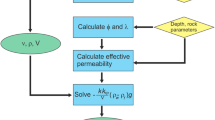Abstract
The migration of fluid petroleum gas, described as fluid potential, depends only on gravity, fluid pressure controlled by depression and capillary force during tectonically stable period; but on tectonic stress during the tectonically active period with severe compression. This method is applied in the Junggar Basin, showing that the migration of Jurassic gas during Cretaceous and Eocene and the migration of Permian gas from Jurassic till the present are determined by capillary force and fluid pressure (including overpressure) which is controlled by depression; the migration of Jurassic gas from Eocene till the present and the migration of Permian gas during Triassic are controlled by tectonic stress.
Similar content being viewed by others
References
Chen Heli, An efficient approach to hydrocarbon migration researches, Oil & Gas Geology (in Chinese), 1995, 16(2): 123.
Helset, H. M., Lake, L. W., Three-phase secondary migration of hydrocarbon, Math. Geol., 1998, 30(6): 637.
Yassir, N. A., Bell, J. S., Relationship between pore pressure, stresses, and present-day geodynamics in the Scotian Shelf, Offshore Eastern Canada, AAPG Bulletin, 1994, 78(12): 1863.
Lee, M. K., Williams, D. D., Paleohydrology of the Delaware Basin, Western Texas: Overpressure development, hydrocarbon migration, and ore genesis, AAPG Bulletin, 2000, 84(7): 961.
Wang Zhenliang, Chen Heli, A palaeohydrodynamic analysis of Upper Palaeozoic Group in Middle Ordos Basin, Acta Sedimentologica Sinaca (in Chinese), 1998, 16(4): 103.
Hubbert, M. K., Entrapment of petroleum under hydrodynamic conditions, AAPG Bulletin, 1953, 37(8): 1954.
England, W. A., Mackenzie, A. S., Mann, D. M. et al., The movement and entrapment of petroleum fluids in the subsurface, J. Geological. Society, 1987, 144: 327.
Burrus, J., Overpressure models for clastic rocks, their relation to hydrocarbon expulsion: a critical reevaluation (eds. Law, B. E., Ulmishek, G. F., Slavin, V. I.), Abnormal Pressures in Hydrocarbon Environments, AAPG Memoir 70, 1998, 35–63.
Wang Zhenliang, Development characteristics of fluid dynamics in reformed basins, Oil & Gas Geology (in Chinese), 2000(1): 24.
Song Yan, Wang Zhenliang, Wang Yi et al., Accumulation of natural gas in the Jungar Basin (in Chinese), Beijing: Science Press, 2000, 62–97.
Author information
Authors and Affiliations
Corresponding author
About this article
Cite this article
Song, Y., Xia, X., Wang, Z. et al. Interaction of fluid dynamic factors in the migration and accumulation of natural gas. Chin. Sci. Bull. 47, 1207–1211 (2002). https://doi.org/10.1007/BF02907611
Received:
Issue Date:
DOI: https://doi.org/10.1007/BF02907611




